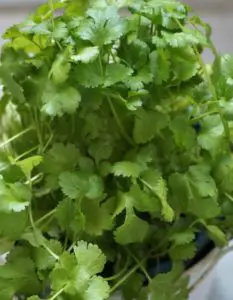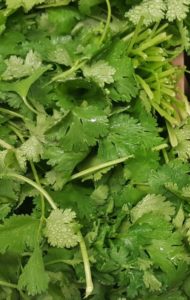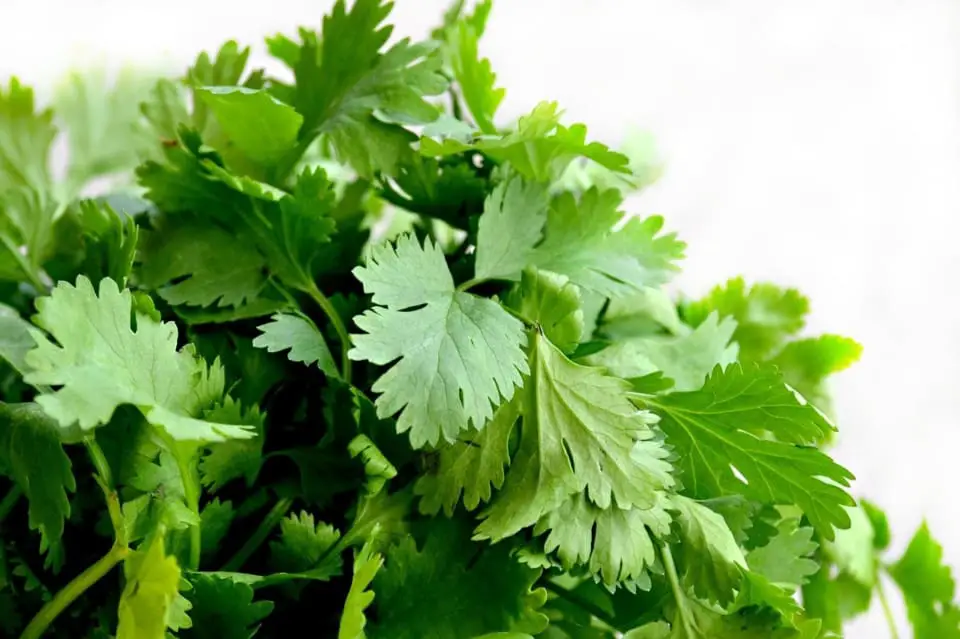Some links in the post are affiliate links and I get a commission from purchases made through some links found in the post.
When we talk about cilantro you may also think about coriander. They are one and the same thing – Coriandrum Sativum, a wonderful herb to eat but often regarded as difficult to grow.
While the plant can be grown outdoors in the garden it is also often grown indoors in pots of all sizes.
What is Cilantro Used for?
 The plant is made up of two sections which give it the two names we recognise. Cilantro is the leavy green foliage that we often chop to add to any number of dishes, often to curries and even to scrambled eggs.
The plant is made up of two sections which give it the two names we recognise. Cilantro is the leavy green foliage that we often chop to add to any number of dishes, often to curries and even to scrambled eggs.
Cilantro also plays an important part in dishes from Africa and the Mediterranean.
Coriander is the seed part which when ground or crushed gives us coriander. Ground coriander also plays a large part in the cuisine of India and can also be added to any other dish you fancy.
The plant does not live for more than a few months. Indeed it is always a race to harvest the green leaves before the plant starts to flower. At this point it is not really suitable for cooking as it develops a bitter flavour.
Also known as Chinese parsley, dhania and cilantro, this is an annual herb, so if you plan on using it regularly you need to replant it each year.
Some people admit that cilantro is a little like Marmite – you either love it or you hate it! Those who love it rely heavily on it to flavour their cooking.
The flowers are small and white or pale pink, and the plant will grow to around 20” tall in the right conditions.
It will need full sun for most of the year unless you live in an area where it is exceedingly hot in the summer. You will need some shade then.
Is Cilantro Difficult to Grow?
Some gardeners will tell you that cilantro is very hard to grow. However, once you understand – as with every plant – the conditions which suit it the best, it is not the problem plant in the garden at all!
You need the soil pH to be 6.5 as this is slightly acidic, which is what cilantro needs to thrive.
Your cilantro plants need to be kept well-watered. The soil should be moist. If the temperatures are very high then you will need to move your plants to a position where they have afternoon shade.
Cilantro is classed as a cool season herb, so you are best growing it in the spring and fall. To plant it in the heat of summer simply does not work. The plant will just shrivel up and die.
You can even occasionally get away with it still producing in a light frost although this is a little too late for cilantro.
If the temperatures get too hot your cilantro will bolt, flower, and die. Once it has started to bolt it will lose some of the wonderful flavour.
If you want a constant supply you should sow seeds every two weeks. Once the plant has bolted you can, however, gather the seedpods.
If you roll them around in your hand you will see that the outside hull comes away and you will be left with the seeds which you can use in your favourite recipes.
If you are enjoying this article, check out our article on do onions grow underground.
How Often Should you Water Cilantro?
Because cilantro needs water it is vital that you keep the soil moist. It does not need to be waterlogged but the soil needs to be moist.
You should aim to water your cilantro every few days. You should be giving your cilantro about 1 inch of water each week per plant.
If you are growing cilantro in containers you will need to water a little more often particularly when the temperatures rise.
Because of the large amount of water you need to give the plant, it is vital that the pot or ground composition provides good drainage. Cilantro has deep roots and needs the soil to be well drained.
Does Cilantro Need a Lot of Water?
An inch of water each week per plant is regarded as quite a lot of water, but if you are to grow your cilantro successfully then you should take this into account and adjust the watering routine of those plants.
How Much Water does your Cilantro Need?
Work on one inch per plant per week, but remember that this is a general rule, and depending on the conditions where you live, this may change either way from a little more to a little less.
What is important is that the soil is always moist and never water-logged.
Can you Overwater Cilantro?
 As with most other plants, yes you can overwater them. You can also over fertilize cilantro, and both will cause damage to the plants. Often the leaves will turn yellow and simply die off.
As with most other plants, yes you can overwater them. You can also over fertilize cilantro, and both will cause damage to the plants. Often the leaves will turn yellow and simply die off.
Overwatering, excess fertilizer, too much sun, and even not enough water will all have the same effect and cause the plant to droop and then die.
Even though cilantro has plenty of leaves to absorb moisture, they can also lose moisture on windy days, just as easily as they can retain too much water if the soil is not right for them.
It is important to remember that most cilantro will in fact wilt on hot days simply because this is a way for them to conserve moisture.
You will notice that it perks up later in the early evening when the temperatures have dropped a little.
Do not be tempted to give them a huge amount of water at this time, rather, move them to a semi-shade area out of the wind.
How do you Know if you are Overwatering Cilantro?
There are two obvious signs that you are overwatering your cilantro, namely:
- Leaves turn yellow
- Stems start to droop
There are only a few reasons for this to happen, the main reason being that the plant is overwatered. The other reasons for these issues are not enough sun and too much nitrogen.
When cilantro starts to turn yellow it is normally a sign of stress due to the above reasons.
Often if a plant is overwatered the soil also lacks drainage, so the soil becomes boggy instead of remaining moist.
If you want to be successful at growing cilantro you must pay attention to the drainage in the pot or ground.
How to Grow Cilantro Indoors in Water
Like many herbs, cilantro can easily be grown indoors in water. In fact, it is very easy to do this.
You can either start your plant in water and then transfer it to a pot or opt for the entirely hydroponic method.
If you choose the first method simply place stems into a jar of clean water and watch the roots develop. When they are long enough, pop them into a pot.
Within a few weeks you will see new sprigs starting to appear and the plant will reach maturity in a month.
The Hydroponic Method
You will need:
- Coriander seeds
- A colander
- A pot of water for the colander to sit over
Soak the seeds in water for several hours.
Drain and crack them. You can use a pestle and mortar for this. Only slightly crack them.
Now place the cracked seeds in the colander which you have placed over the bowl/pot of water.
Cover the seeds with a wet paper towel and keep it wet for several days.
Remove the paper towel and leave the cilantro to grow.
Make sure to replenish the water in the bowl or pot occasionally.
In about 20 days you should have a colander of lush cilantro, all ready to pick.
A note about this method is that you will not have any wilting issues and you can harvest just as much as you need for a recipe.
You may also like: Can you grow carrots hydroponically.
What about Growing Cilantro Inside?
 Cilantro is very easy to grow inside the house, provided it has the right conditions.
Cilantro is very easy to grow inside the house, provided it has the right conditions.
Use a decent sized container, not the tiny ones you get from the supermarket when you buy it. Cilantro has long roots and needs at least a 10” container to do well.
Sunlight
Find a sunny windowsill for your new plant. Cilantro likes indirect, bright sun but does not want to be placed in direct sunlight.
Ideally the morning sun in an east-facing window will suit it.
Humidity and Temperature
You can extend the season by keeping the cilantro in an area where the temperature is about 70 degrees. The plant also needs slightly moist air around it so misting daily is a good idea.
Watering
Be sure to check the soil and keep it moist. It should not be soaking wet and boggy but needs to feel damp when you stick your finger into it. Remember that it needs about 1” per plant per week.
Drainage
Make sure that the pot you use has holes in the base and that the soil drains well. Cilantro does not like its roots to be wet.
Final Thoughts
Once you have mastered the art of growing cilantro you will never need to buy it again! In the right conditions you can grow it throughout the year and have a handful ready any time you like.
With a little understanding, there is no reason why this herb should not find a place in your herb garden or on your windowsill.
Before you go, here are some more related articles I encourage you to read below to help solve more of your gardening issues:
How much sun does lettuce need


